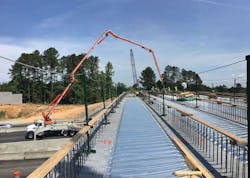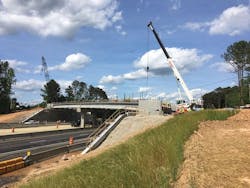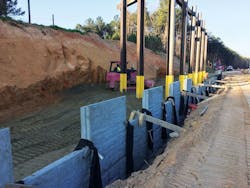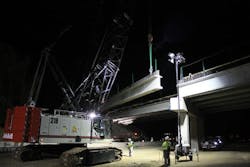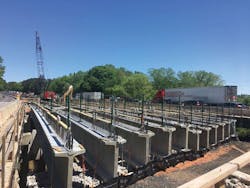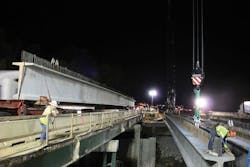Mobility investment program in Georgia launches with I-85 widening
The state of Georgia has had its fair share of major highway projects over the last few years, and it is not about to slow down any time soon.
Back in 2015, the Georgia legislature passed the long-term Transportation Funding Act (TFA), a measure that provided a significant boost in funding for highway and bridge projects and enabled the Peach State to address its most critical transportation needs.
According to a TRIP report, passage of this legislation has allowed the state to invest in numerous highway improvements. This includes the introduction of the Georgia DOT’s (GDOT) Major Mobility Investment Program (MMIP)—one of the largest funding programs the state has ever attempted to deliver.
“The key goal behind the program is to provide reliable trip times and relieve traffic congestion on our most congested corridors throughout the state,” Tim Matthews, MMIP program manager with GDOT, told Roads & Bridges. “There’s 11 projects in the program, most of which are in the metro [Atlanta] area.” GDOT’s efforts to significantly reduce congestion along key freight and passenger corridors through the MMIP are projected to result in a 5% reduction in delays and travel times by the year 2030.
The initial 11 projects in the MMIP were pinpointed by transportation officials for their potential to create additional capacity, improve freight movement, provide transportation improvements and efficiencies, enhance safety, and decrease travel times. Combined, these projects will add over 300 new lane-miles in Georgia’s metro areas.
The first MMIP project on the docket is the widening of I-85 beginning at I-985 and extending north to S.R. 53, which aims to reduce congestion across Gwinnett, Barrow, and Jackson counties. This phase of the I-85 widening is the first of three interstate widening projects currently included in the MMIP. The goal of these improvements is to reduce traffic congestion and improve overall safety in the area.
One major component of the widening project involves the replacement of three overpass bridges along the I-85 corridor at Sprout Springs Road, Flowery Branch Road, and Jesse Cronic Road. All three structures were over 50 years old and were functionally obsolete, so their replacement was deemed a necessity for this project.
GREATER CAPACITY
Between 2000 and 2017, Georgia’s population grew by 27%, according to TRIP. Over the course of that same timeframe, vehicle travel on the state’s highways increased by 19%. As such, traffic congestion has become an issue throughout the state, particularly in metro areas, as 55% of Georgia’s urban interstate highways experience congestion during peak travel hours. The I-85 widening project is one such effort to relieve traffic congestion along a major interstate.
“Once completed, the I-85 widening project will add a lane, which will add capacity to the roadway, which will allow traffic to move through the corridor more efficiently with less delay and less potential for accidents as you’re traveling through,” Marlo Clowers, P.E., DBIA, senior project manager at GDOT, told Roads & Bridges. The interstate will gain a general-purpose lane in both directions of travel.
The stretch of highway undergoing widening covers just over 10 miles between I-985 and S.R. 53. The new lanes will take the place of the currently existing grass median separating the two directions of travel, along with a paved shoulder and a concrete median barrier. “All the widening was contained inside the median, so no additional right-of-way was required,” Clowers said.
Work on the I-85 widening project began in July 2017, when the design-build contract with C.W. Matthews Contracting Co. was executed. The notice to proceed for design was issued in December of 2017, and construction began in July 2018—bringing the project into what is now over a full year of construction under an accelerated process.
In addition to replacing overpass bridges as well as a mainline bridge over the Mulberry River, work on I-85 consists of widening the interstate by adding a lane in each direction, which will add capacity to the roadway, allowing traffic to move through the corridor more efficiently. Another component of the project includes the installation of sound barriers to protect the public from unnecessary noise coming from the interstate.
TACKLING BRIDGES
One major component of the widening project involves the replacement of three overpass bridges along the I-85 corridor at Sprout Springs Road, Flowery Branch Road, and Jesse Cronic Road. All three structures were over 50 years old and were functionally obsolete, so their replacement was deemed a necessity for this project. “Their lane widths, shoulder widths, or methods of handling drainage were beneath the standards that we currently have because they were 50-plus years old,” Clowers explained. “So they were structurally sound, but functionally obsolete. So this project will update those bridges by bringing them up to current design standards.”
During construction of the three overpass bridges, GDOT had to implement temporary detours along the roadways where the bridge replacements occurred. “There was a need to—in order to get [the bridge replacements] done quickly—be able to close the roads that those bridges pass over I-85 on, so that you could take out the old bridge and build the new bridge,” Clowers said. “And this area actually lent itself to that because there are a lot of detour routes, a lot of connecting roadways that allowed us to complete the construction more efficiently.”
In addition to the replacement of three overpass bridges, GDOT had to replace one of its mainline bridges along I-85 over the Mulberry River which consists of two structures, one for each direction of travel. I-85 over Mulberry River sits at the border of the Barrow and Jackson county line, and the existing parallel structures were each two lanes in width. “It’s gonna be replaced with two parallel, three-lane bridges,” Clowers said. “And the widening of those new bridges is being accomplished by widening the bridge to inside the median.”
Both existing structures of the mainline bridge over Mulberry Creek were each 228 ft long with two 12-ft lanes, a 6-ft left shoulder, and a 12-ft right shoulder. The northbound bridge has a sufficiency rating of 72.3, while the southbound structure is rated at 84.2. The new structures will be around 198 ft long and will consist of three 12-ft lanes, one 12-ft inside shoulder, and one 12-ft outside shoulder. The northbound structure will have typical out-to-out width of 63.13 ft, while the southbound bridge will have typical out-to-out width of 61.54 ft.
As the new structures over Mulberry Creek will consist of two parallel, three-lane bridges, a minor separation will exist between the two. “So to the naked eye, it will look like one bridge, but it will actually be two bridges,” Clowers explained. “The existing bridge was two parallel, two-lane bridges with an apparent, significant separation between the two.” Currently, the widening construction for the new bridges is taking place in the median area. Once that section of the bridge is complete, traffic will be switched over to the new section while the two existing bridges—both northbound and southbound—will be removed and replaced with the new structures.
Both existing structures of the mainline bridge over Mulberry Creek were each 228 ft long with two 12-ft lanes, a 6-ft left shoulder, and a 12-ft right shoulder. The new structures will be around 198 ft long and will consist of three 12-ft lanes, one 12-ft inside shoulder, and one 12-ft outside shoulder. As the new structures over Mulberry Creek will consist of two parallel, three-lane bridges, a minor separation will exist between the two.
MOVING ALONG
For the folks at GDOT, some of the biggest challenges faced included staging construction in an area with such significant traffic volumes. “There’s a lot of truck traffic and there’s a lot of travel at peak times through the area,” Clowers said. In order to keep traffic moving along, the initial stages of construction are restricted to the median area for the road widening. While work is ongoing, the median remains sectioned off with barrier separations from traffic on the outer sides. Once work in the median is complete, including the median lanes and the concrete barrier, traffic will then be switched over to the new lanes while shoulder work and additional paving work required for the existing lanes is carried out.
As construction carries on along I-85, GDOT is making an effort to maintain a culture of safety within its work zones. “When you’re working adjacent to traffic that’s traveling 67 mph, [safety] is always a concern,” Clowers said. “So GDOT does everything we can to keep our workers and our contractors safe during the construction project.” It is for those safety concerns that GDOT has a requirement to maintain a barrier between the work zone and vehicular traffic. Additionally, safety requirements are in place for workers to be securely tethered or attached to the bridge when working on a bridge overhead. GDOT also enforces that the contractor monitor the work zone frequently to ensure all safety requirements are met throughout the construction process.
GDOT also is taking steps to boost safety for the traveling public through the installation of some additional features along I-85. This includes the implementation of a glare screen along the median, which is designed to prevent headlights coming from one direction of travel from obstructing the view of the roadway for opposing traffic, in order to ensure safer navigation for all motorists. Work on I-85 will also implement additional guardrail, signage, and striping along the highway. Additionally, as a courtesy to the surrounding community along I-85, GDOT is installing sound barriers to protect the public from unnecessary noise coming from the interstate.
An additional safety and traffic management component of the I-85 widening project is the implementation of intelligent transportation system (ITS) features. Along this corridor, GDOT is installing a network of cameras and message boards that communicate with each other to inform the traveling public of the conditions of the roadway so that motorists can make informed decisions for their travel. The project will add 19 cameras, some new cameras to existing poles in addition to brand new poles, as well as a couple of ramp meters, and about four changeable message boards as part of the ITS infrastructure.
The addition of the new lane miles along I-85 is projected to reduce delay along the corridor by 56% between S.R. 53 and U.S. 129. The completed project is expected to increase highway capacity to over 100,000 vehicles. The I-85 widening project is on schedule to be substantially complete by July 2020, with final acceptance in October 2020. “There are four early-open segments that were contractually required,” Clowers said. “The first two will be done by the end of the year, which will open up about 5 miles of the project.”
After work is finished along this stretch of I-85, GDOT will look at phase 2 of the I-85 project, which connects further north from S.R. 53 to U.S. 129, in what will be the next step of the MMIP. Similar work will be carried out on this segment, with a third lane added in both directions of the highway. In the near future, the department will also be working on some of its most congested corridors by adding express lanes to both I-285 and S.R. 400.
-----------
All images courtesy of KCI.


